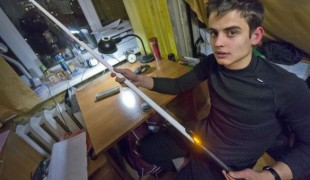- 7543
- 559
- 3
- 9
- 0
- Help Ukraine
About the solution
Carmen Papalia attempted to produce a system of access for himself that would better serve his needs than a white cane. He created Mobility Device, a collaborative performance that allows him to claim agency by abandoning his white cane for a marching band that serves as his primary navigation system. As part of a site-specific performance of Mobility Device, he explored downtown Santa Ana while the Great Centurion marching band from Century High School provided musical cues, indicating objects, obstacles, and other information that they felt might be relevant to him on his journey.
With Mobility Device, fixtures such as curbs, lampposts, and sandwich boards become notes in the soundscape of a place. The arrangement proposes the possibility of user-generated, creative, process-based systems of access while representing a noninstitutional and non institutionalizing solution for the problem of the white cane.
“I saw this cane as an opportunity to collaborate”, he said.
As a piece of music, Mobility Device is an extension of the musicality of the white cane, bringing attention to the things that the implement, on any occasion, might touch and give rise to sound.
“By taking on projects such as Mobility Device and Blind Field Shuttle, I came to realize my way of being in the world as a mode of orientation that has the potential to uncover entire unseen bodies of knowledge. This inspired me to consider everything from how cultures might have evolved if the origins of communication had centered on the tactile sense to what a typical museum experience for the non visual learner might be. I condensed my thinking on these topics into an article for a special issue of Disability Studies Quarterly and drafted a list of interventions that would reframe access in the museum as an open creative process. Near the end of the article, I offered my services as an access coordinator to any institution that would have me”, Papalia explained.
His work has been featured in exhibitions and engagements at such venues as the Whitney Museum of American Art, the Guggenheim Museum, and the Museum of Modern Art.
Adapted from:
http://bit.ly/2iKN4RD
http://bit.ly/2b72Hxk
http://bit.ly/2xy7BLS
More info:
https://carmenpapalia.com
https://youtu.be/u1fRXpg6IFQ
This solution shall not include mention to the use of drugs, chemicals or biologicals (including food); invasive devices; offensive, commercial or inherently dangerous content. This solution was not medically validated. Proceed with caution! If you have any doubts, please consult with a health professional.
DISCLAIMER: This story was written by someone who is not the author of the solution, therefore please be advised that, although it was written with the utmost respect for the innovation and the innovator, there can be some incorrect statements. If you find any errors please contact the patient Innovation team via info@patient-innovation.com
-
-
181
-
0
-
1653

Inclusio - Connecting businesses and people with disabilities, ensuring seamless access, personalized support, and truly inclusive spaces.
Urban exploration
Blindness
In Person service
App (Including when connected with wearable)
Impaired movement
Gait abnormalities (e.g., walking difficulties, unsteady gait)
Loss of balance
Seizures
Tremors
Trouble with fine motor skills (e.g., writing, buttoning clothes)
Twitching or involuntary movements (myoclonus)
Building Supportive Community Relationships
Promoting inclusivity and social integration
Raise awareness
Neurology
Ophthalmology
Otorhinolaryngology
Physical Medicine and Rehabilitation
Serbia
-
-
-
265
-
0
-
2977

City Able - a startup developed by wheelchair users to make cities more accessible
Urban exploration
MOVING IN A WHEELCHAIR: Moving using a wheelchair.
WALKING WITH A WALKING AID: Walking with a walking aid
In Person service
Restoring mobility
Promoting self-management
Promoting inclusivity and social integration
Raise awareness
Physical Medicine and Rehabilitation
Solutions for Disabled people
Portugal
-
-
-
1072
-
8
-
27349

Der sprechende Stock für Sehbehinderte
WALKING WITH A WALKING AID: Walking with a walking aid
Urban exploration
COMMUNICATION: Communicating, whether by speaking, listening, or other means
Blindness
5 Senses support devices: (glasses, hearing aids, headphones...)
Assistive Daily Life Device (to help ADL)
AI algorithm
Vision problems
Restoring mobility
Promoting self-management
Managing Neurological Disorders
Promoting inclusivity and social integration
Ophthalmology
Solutions for Disabled people
Russian Federation
-
 en
en